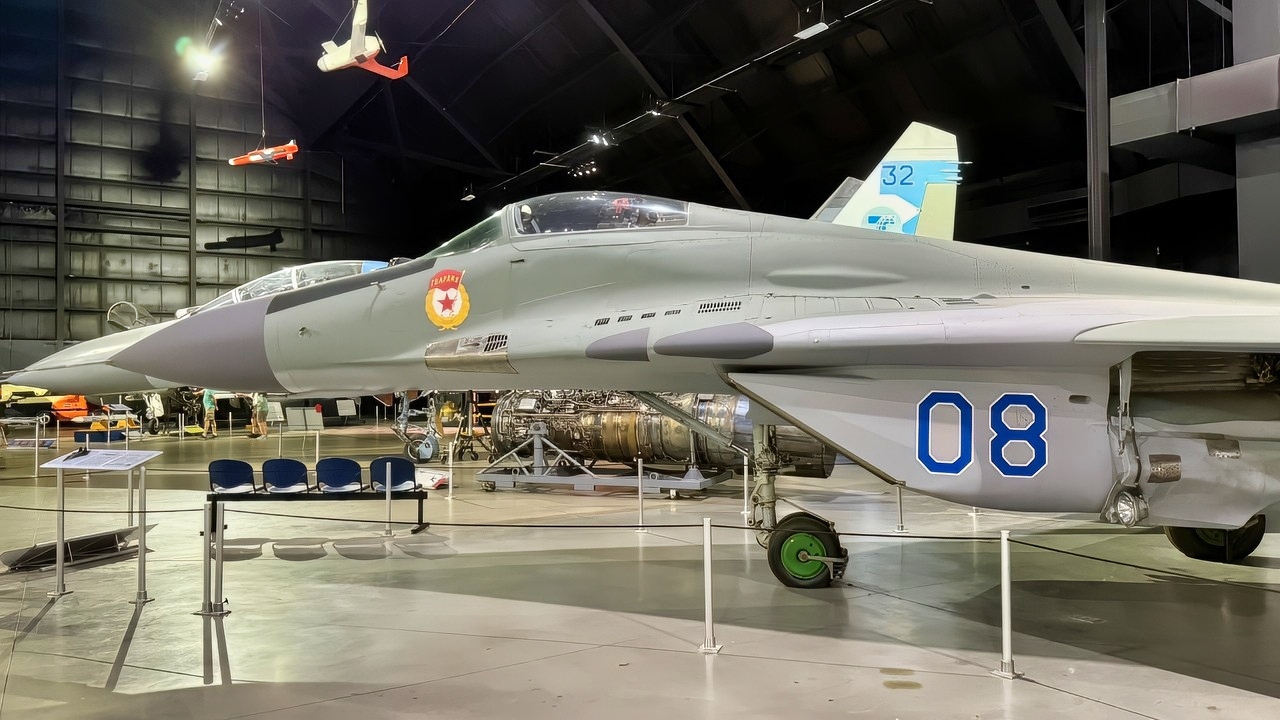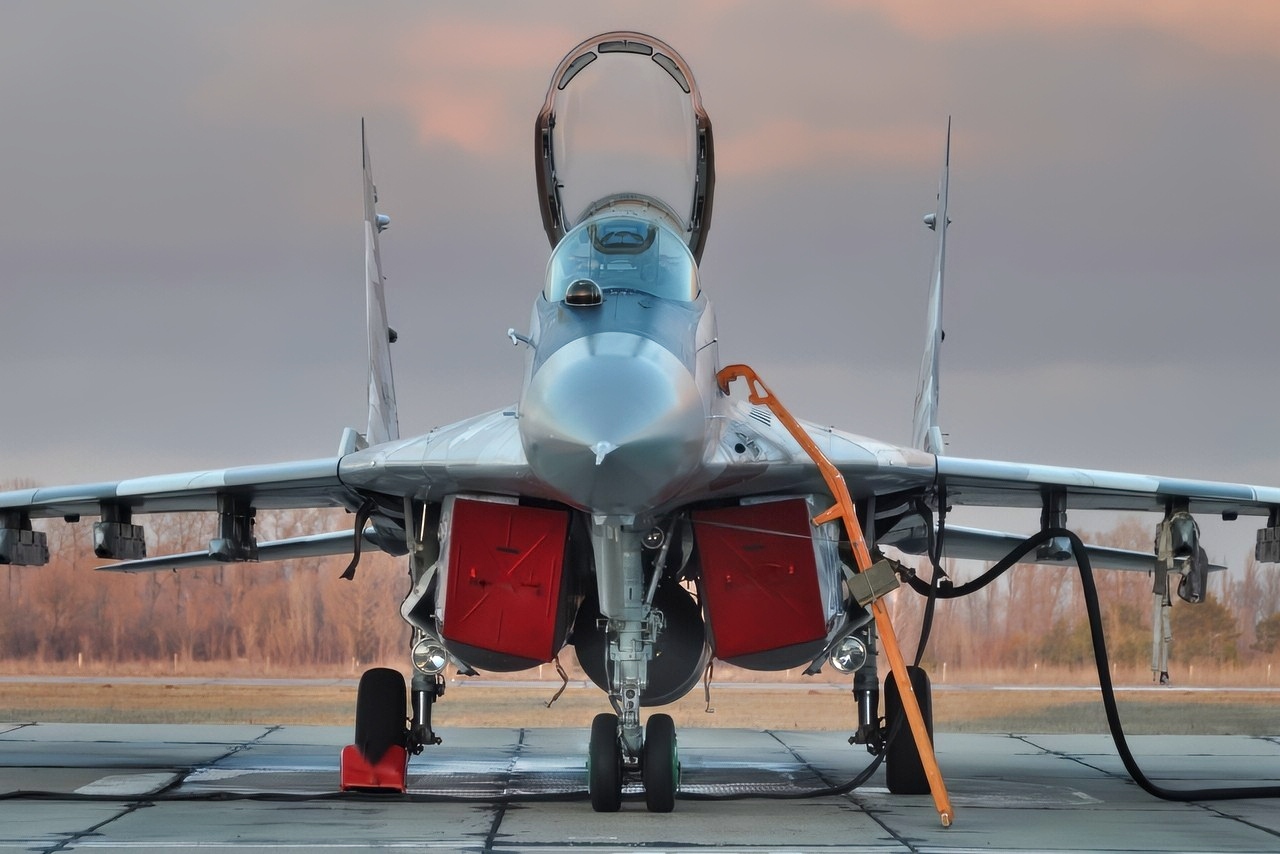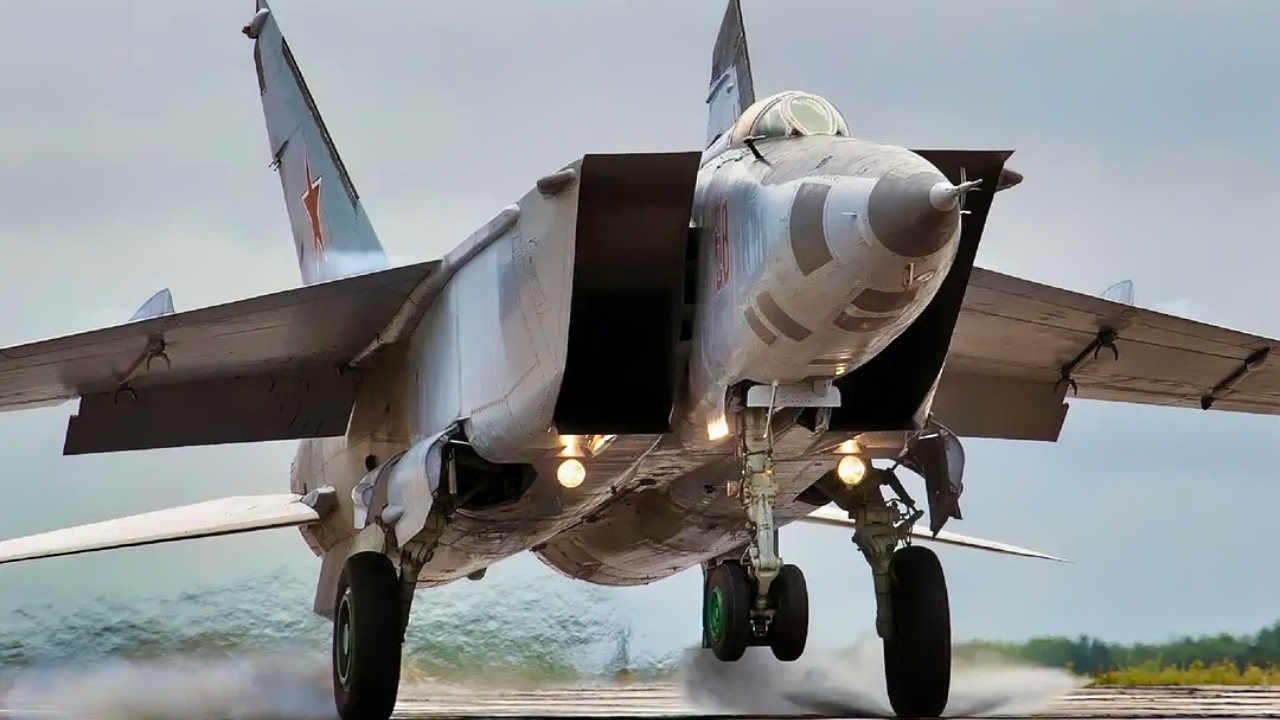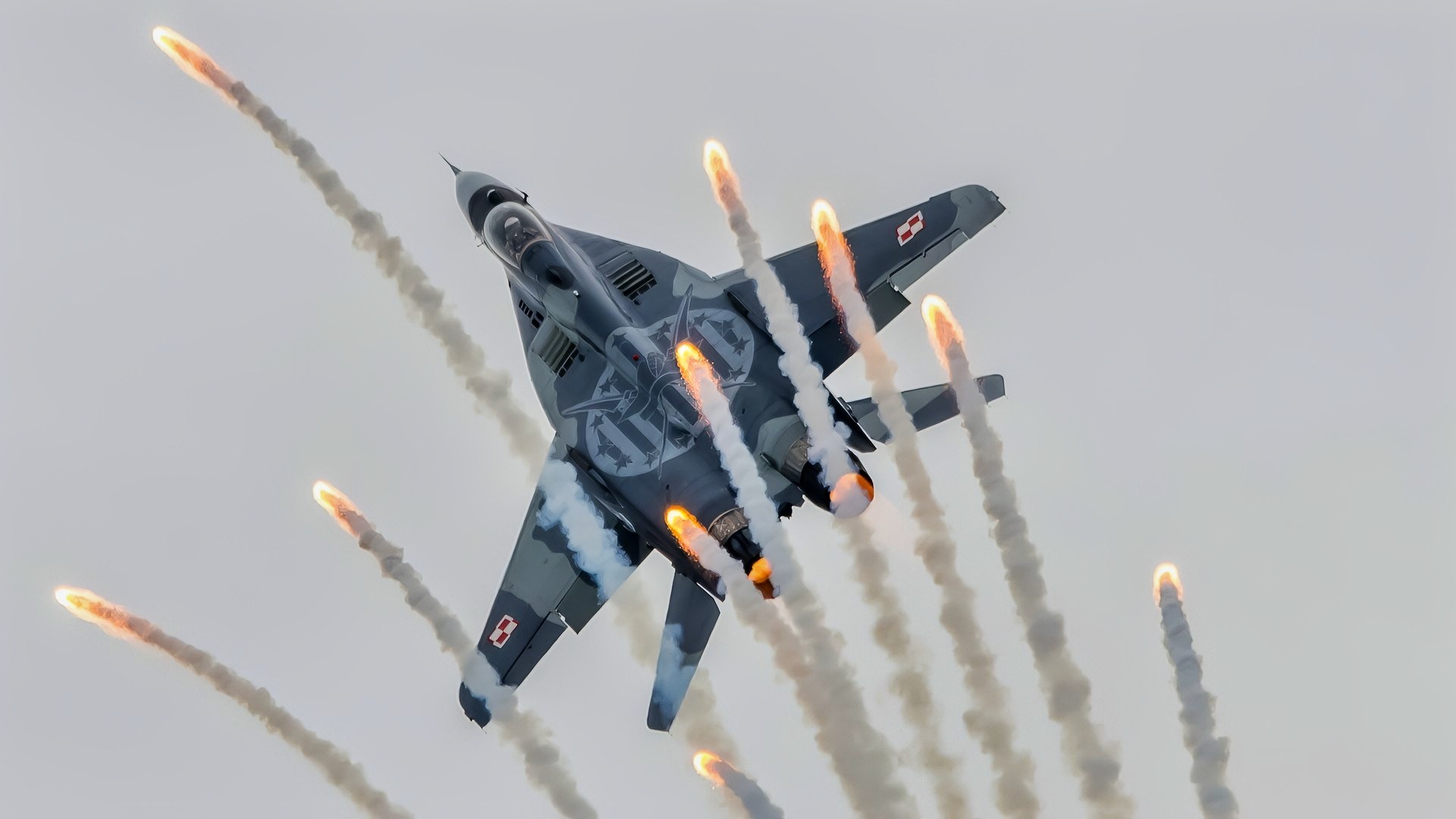Key Points and Summary – On a spring night in 1989, Soviet fighter pilot Aleksandr Zuyev staged one of the Cold War’s boldest defections—stealing a frontline MiG-29 “Fulcrum” and flying it to Turkey.
-Disillusioned with the Soviet system and convinced reforms wouldn’t fix it, he planned an audacious escape: disable pursuit, slip airborne, and reach NATO airspace before the alarm could tighten.

Real MiG-29 at USAF Museum in Dayton. Image Credit: National Security Journal.
-The West gained a rare, hands-on look at Moscow’s hottest fourth-generation fighter, including its helmet-sighted missile combo that would shape
-Western tactics and upgrades. Zuyev’s caper belonged to a tradition that included the MiG-25 defection to Japan—only this time, the prize was agility, avionics, and the near-future of air combat.
A Pilot, a System, and a Breaking Point: How the West Got a MiG-29 Fulcrum Fighter
By the late 1980s, the Soviet Union was fraying: reforms from the top, scarcity from the bottom, and rising national tensions in between. In that atmosphere, Aleksandr Zuyev—young, talented, and on the fast track in a prestigious fighter regiment—saw two conflicting truths. First, he had the world’s attention at his fingertips; he flew the MiG-29, the sleek, agile “Fulcrum” the West had whispered about for years. Second, the system he served seemed increasingly hollow. Promotions had more to do with politics than performance, supplies were a headache, and truth traveled slower than rumor.
Defection is never about one grievance. It’s the slow accumulation of them, welded to a single opening. For Zuyev, that opening sat right outside his revetment: a nearly new MiG-29 with fuel, weapons safed, and just enough darkness left in the sky to hide the first minutes of a desperate sprint for the border.

MiG-29 Fighter. Image Credit: Creative Commons.
Why a MiG-29 Defection Mattered So Much
Western intelligence had photos, flightline glimpses at air shows, and a handful of carefully managed demonstrations of the MiG-29. None of that replaces time with the real article. The “Fulcrum” captured the spirit of Moscow’s fourth-generation design approach: two engines for punch and survivability, a big leading-edge root extension for lift at high angles of attack, and the party trick that grabbed NATO’s attention—a helmet-mounted sight cued to the R-73 short-range missile, allowing a pilot to look off-boresight and launch lethal, high-agility shots.
If you want to understand a fighter, you need to touch its wiring, read its maintenance logs, and see what systems engineers prioritized when no one’s watching. That’s what a live airframe in NATO hands buys you.
The Decision: From Disillusion to Resolve
Zuyev later described his break with the Soviet state not as a snap but as a slow-motion divorce. He bristled at politically driven evaluations. He resented a culture that dressed up problems instead of fixing them. And he feared that the union’s reforms were too late and too shallow to spare the next generation of pilots from the same treadmill. Defecting would mean abandoning friends and family, crossing a frontier with guns on both sides, and living forever as a man whose most famous moment would be a betrayal in the eyes of his old comrades.
What turned resolve into action was opportunity: a predictable rotation of guards, a night shift with fewer eyes, and the knowledge that Turkey’s coast lay just minutes of low-level flight away from his base in Soviet Georgia.

MiG-29 Fighter. Image Credit: Creative Commons.
The Plan: Delay Pursuit, Get Airborne, Vanish
A one-man hijack of a combat jet is equal parts choreography and nerve. Zuyev’s plan focused on three things: stall the alarm, deny a quick chase, and leave the radar picture before anyone could build a firing solution.
Accounts of that night capture the essentials. He softened the alert posture on base, taking advantage of trust and routine. He disabled or delayed the jets most likely to launch after him. He kept phone lines and coordination channels from snapping instantly into a tight net. Then he strapped in, woke up two engines that sounded like thunder under a blanket, and rolled for the runway.
Once airborne, there was only geometry and fuel. The Black Sea’s coastline bends toward Turkey; a low-level dash along that dark water, especially in the pre-dawn hush, buys precious minutes before search radars stitch together a picture of what just happened.
The Flight: From Soviet Georgia to a Turkish Runway
Defectors rarely get a clean ride. Radar operators compare plots. Interceptors launch. Political chains light up. Zuyev’s best defense was to arrive in NATO airspace before the Soviets had time to put teeth on the trail. Turkey scrambled fighters. Radios barked in multiple languages as he neared Trabzon. He declared an emergency—fuel, foreign airspace, a stolen jet—and he did the one thing fighters do in unfamiliar skies when they want to live: cooperate.
He landed under escort. No victory roll. No theatrics. Just the bone-deep relief that comes when wheels kiss a runway that belongs to strangers who have reasons not to shoot you.
The Prize: What the West Learned From a Live MiG-29 Fulcrum
Turkey returned the MiG-29 to the Soviet Union rather quickly; everyone had politics to manage, alliances to keep smooth, and bigger fish to fry. But before that jet went home, Western specialists got a crash course in Fulcrum reality—not just the glossy airshow version.
What mattered wasn’t headline speed or brochure climb rate. It was the integration: how the radar talked to the weapon system, how robust the electrical buses and cooling loops were, the way the cockpit presented choices to a pilot at 8 g’s with sweat in his eyes. Of particular interest was the helmet-sight plus R-73 combination. Western pilots had always trained to keep an opponent in a tight forward cone to launch a heat-seeker; the Fulcrum let a pilot “look and shoot” far off the nose, then let a high-agility missile do the rest. That single concept echoed through NATO training syllabi and hardware wish lists for years.
In short: the West stopped guessing. It started benchmarking.
A Precedent in the Rearview: The MiG-25 That Landed in Japan
Zuyev’s leap had a famous ancestor.
In 1976, Viktor Belenko landed his MiG-25 “Foxbat” in Japan, giving Western analysts an unprecedented look at what had been painted as a super-fighter.
The uniforms expected exotic titanium and space-age wizardry; they found hard steel, brute-force engines, and a colossal radar that impressed on range but not finesse. The lesson wasn’t “Soviet jets are bad.” It was subtler: Soviet jets are built to Soviet requirements—fast, rugged, and optimized for a different set of tradeoffs than NATO designers habitually made.

MiG-25 Foxbat Fighter. Image Credit: Creative Commons.

MiG-25. Image Credit: Creative Commons.
Zuyev’s MiG-29 defection extended that education into the fourth generation. If Belenko’s Foxbat was a missile-interceptor with wings, Zuyev’s Fulcrum was a knife fighter, agile and lethal in the arena where seconds and sightlines decide who goes home.
Debrief: What the Fulcrum Told NATO About the Next Air War
A few themes crystallized once engineers and tacticians had time with the real jet:
Short-Range Lethality Was Changing. The helmet cueing plus a nimble missile meant the old, rigid geometry of dogfights was out of date. Western services would soon fast-track helmet displays and high-off-boresight missiles of their own.
Avionics Maturity Mattered. The Fulcrum’s raw performance was top-tier; its sensors and data handling were good but not seamlessly fused. Western jets—especially those with advanced radars and datalinks—could exploit that gap by turning information into position advantage.
Sustainment Was a Strategic Weapon. Even a great jet stumbles when spares are scarce and maintenance is reactive. NATO trained to fight the aircraft and the system behind it—denying the opponent the stability to use his peak.
None of those insights required trashing the Fulcrum. Quite the opposite: adversary respect grew. And later, when ex-East German MiG-29s flew in NATO colors, exercises validated what Zuyev’s airframe suggested—in the phone-booth fight, the Fulcrum could be terrifying.
The Human Cost: Aftermath for a Man Without a Country
Defection solves the problem of “getting out.” It creates the problem of where to land in life. Zuyev made his case for asylum, cooperated with debriefings, and built a new identity in the West. He wrote about his journey—part confession, part critique, part love letter to flying—and found a small circle of people who understood that most of life sits in gray areas. He never returned to the system he escaped. He couldn’t. That’s the price hidden in the headlines.
Beyond the Headlines: What “One Jet” Means in a Strategy
People often ask whether a single defection can shift the balance of power. The honest answer is no—and yes. No, one jet does not remake a war. Yes, one jet can tilt a thousand small decisions—about what to train to, what to fund, what to doubt in your own assumptions. What Zuyev handed the West was not a trophy; it was a mirror. NATO planners saw what Soviet engineers did well, what they skipped, and what that meant inside real cockpits at the merge.
They also saw a human being willing to light his life on fire rather than keep serving what he believed was a lie. In a Cold War measured in megatons and maps, that kind of choice has its own gravitational pull.
Why This Story Still Resonates
Today’s jets are smarter, stealthier, and wired together in ways the 1980s only hinted at. But the themes haven’t aged. Air forces still obsess about what’s inside the other guy’s black boxes. Pilots still look for an angle that turns numbers and speed into surprise and survival. And now as then, the most dangerous thing is the thing you don’t know you don’t know.
That’s why Aleksandr Zuyev’s midnight sprint matters. It’s a reminder that intelligence is sometimes a single brave person with a plan and a few good minutes of darkness. It’s also a reminder that technology doesn’t float in a vacuum. It lives inside bureaucracies, maintenance hangars, and the hearts of people who either believe in the system—or can’t anymore.
The Other Side of the Ledger: Moscow’s View
From the Soviet perspective, Zuyev’s act was treason with strategic consequences. It embarrassed units charged with guarding elite equipment. It gave potential adversaries a close look at a crown-jewel fighter. And it offered a propaganda victory to the West at a time when the Soviet Union could least afford it. Investigations followed. Procedures tightened. Trust eroded where it was already thin. That, too, is part of the cost: the chilling effect inside a force that must run on confidence and cohesion.
The Line From Belenko to Zuyev—and Onward
String the two famous defections together, and you can trace an arc of learning on both sides. The West learned to assess Soviet hardware by its own design logic, not Western expectations. The Soviet—and later Russian—side learned to harden the human seam: background checks, tighter access, more eyes in the squadron bars and base kitchens where gripes turn into plans.
And yet, as long as people build machines and trust other people to fly them, that seam remains. It’s where history sneaks in.
About the Author: Harry J. Kazianis
Harry J. Kazianis (@Grecianformula) is Editor-In-Chief and President of National Security Journal. He was the former Senior Director of National Security Affairs at the Center for the National Interest (CFTNI), a foreign policy think tank founded by Richard Nixon based in Washington, DC. Harry has over a decade of experience in think tanks and national security publishing. His ideas have been published in the NY Times, The Washington Post, The Wall Street Journal, CNN, and many other outlets worldwide. He has held positions at CSIS, the Heritage Foundation, the University of Nottingham, and several other institutions related to national security research and studies. He is the former Executive Editor of the National Interest and the Diplomat. He holds a Master’s degree focusing on international affairs from Harvard University.
More Military
The F-22 Raptor Stealth Fighter Still Haunts the U.S. Air Force
The U.S. Navy’s Big Nuclear Attack Submarine Mistake Still Stings
China’s J-20 Mighty Dragon vs. F-22 Raptor Stealth Fighter Summed Up in 4 Words
Why Is a U.S. Navy Aircraft Carrier Still Damaged 8 Months After a Collision?










